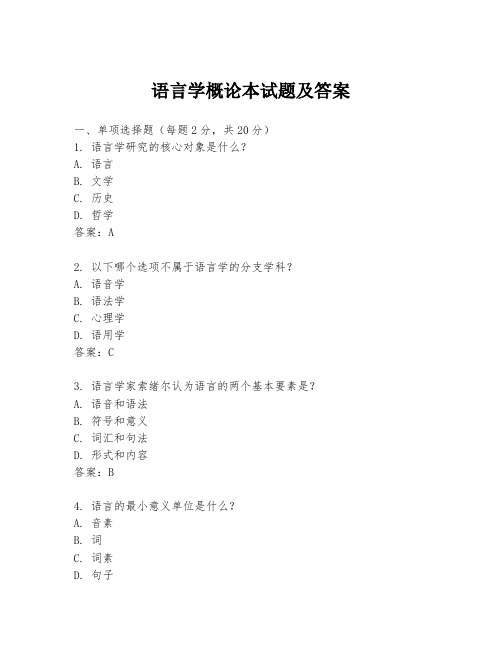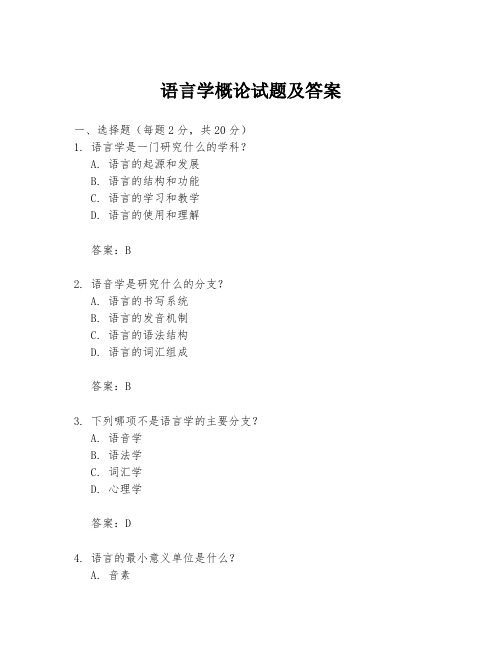语言学概论试题
- 格式:doc
- 大小:26.50 KB
- 文档页数:2

语言学概论试题及答案一、选择题(每题2分,共20分)1. 语言学是研究什么的科学?A. 语言的物理特性B. 语言的社会功能C. 语言的结构和功能D. 语言的起源和发展2. 语音学研究的主要内容是什么?A. 语言的语法结构B. 语言的词汇构成C. 语言的发音机制D. 语言的书写形式3. 下列哪个不是语言学的分支?A. 语音学B. 语法学C. 词汇学D. 化学4. 语言的最小意义单位是什么?A. 音素M. 词汇C. 语素D. 句子5. 语义学研究的是语言的哪一方面?A. 语言的发音B. 语言的意义C. 语言的书写D. 语言的语法6. 语言的词汇量是如何增长的?A. 通过新词的创造B. 通过旧词的淘汰C. 通过语言的混合D. 通过语言的简化7. 什么是语言的方言?A. 一种语言的书面形式B. 一种语言的口头形式C. 一种语言的地区变体D. 一种语言的官方标准8. 语言的同化现象是指什么?A. 语言的统一B. 语言的分化C. 语言的借用D. 语言的变异9. 语言的转换是指什么?A. 语言的翻译B. 语言的转写C. 语言的转述D. 语言的转换10. 什么是语言的语境?A. 语言的使用环境B. 语言的书写环境C. 语言的发音环境D. 语言的语法环境二、填空题(每题2分,共10分)11. 语言学的两大分支是________和________。
12. 语言的音位系统是由________构成的。
13. 语言的语法规则包括词法规则和________。
14. 语言的词汇化是指________转化为词汇的过程。
15. 语言的语用学研究的是语言在________中的使用。
三、简答题(每题10分,共20分)16. 简述语言的交际功能。
17. 简述语言的规范性与变异性。
四、论述题(每题15分,共30分)18. 论述语言与文化的关系。
19. 论述语言的演变过程及其影响因素。
五、案例分析题(每题20分,共20分)20. 请分析一种方言的形成过程,并讨论其对标准语的影响。

语言学概论本试题及答案一、单项选择题(每题2分,共20分)1. 语言学研究的核心对象是什么?A. 语言B. 文学C. 历史D. 哲学答案:A2. 以下哪个选项不属于语言学的分支学科?A. 语音学B. 语法学C. 心理学D. 语用学答案:C3. 语言学家索绪尔认为语言的两个基本要素是?A. 语音和语法B. 符号和意义C. 词汇和句法D. 形式和内容答案:B4. 语言的最小意义单位是什么?A. 音素B. 词C. 词素D. 句子答案:C5. 以下哪个选项是社会语言学的研究内容?A. 语音变化B. 语言变异C. 语言习得D. 语言起源答案:B二、填空题(每题2分,共20分)1. 语言学的创始人是______。
答案:索绪尔2. 语言的三个基本功能是表达、______和指示。
答案:交流3. 语言的两种形式是______和书面语。
答案:口语4. 语言的两种基本结构类型是孤立语和______。
答案:屈折语5. 语言学的研究方法包括______和比较法。
答案:描写法三、简答题(每题10分,共30分)1. 简述结构主义语言学的基本观点。
答案:结构主义语言学认为语言是一个符号系统,由形式和意义两个部分组成。
它强调语言内部的系统性和结构性,认为语言的各个成分之间存在着相互依赖的关系。
2. 举例说明什么是语言的同源词。
答案:同源词是指来源于同一原始词汇的现代词汇,例如英语中的“mother”和德语中的“Mutter”都是从原始印欧语的“*mater”演变而来。
3. 描述一下什么是语言的方言。
答案:方言是指在同一个语言内部,由于地理、社会、历史等因素而形成的不同变体。
它们之间在语音、词汇、语法等方面存在差异,但通常可以相互理解。
四、论述题(每题15分,共30分)1. 论述语言的社会功能。
答案:语言的社会功能包括但不限于:(1)交流信息,使人们能够相互沟通和理解;(2)社会认同,语言是社会群体身份的标志;(3)文化传承,语言是文化信息的载体;(4)教育工具,语言是教育和学习的基础;(5)法律规范,法律文件和法律程序通常以语言形式存在。

语言学概论试题及答案一、单项选择题(每题2分,共20分)1. 语言学是研究语言的科学,其研究对象包括:A. 语言的物理属性B. 语言的社会属性C. 语言的心理属性D. 所有选项答案:D2. 下列哪项不是语言学的分支学科?A. 语音学B. 语法学C. 语用学D. 化学答案:D3. 语言的最小意义单位是:A. 音素B. 词C. 语素D. 句子答案:C4. 语言的任意性是指:A. 语言符号的发音与其意义之间没有必然联系B. 语言符号的发音与其意义之间有必然联系C. 语言符号的书写与其意义之间没有必然联系D. 语言符号的书写与其意义之间有必然联系答案:A5. 语言的线性特征是指:A. 语言只能逐个音素地表达B. 语言只能逐个词地表达C. 语言只能逐个句子地表达D. 语言只能逐个语素地表达答案:A6. 语言的层级结构包括:A. 音素、词、句子B. 语素、词、句子C. 词、短语、句子D. 所有选项答案:B7. 语言的变异性表现在:A. 语音的变化B. 词汇的变化C. 语法的变化D. 所有选项答案:D8. 语言的交际功能包括:A. 表达思想B. 传递信息C. 建立社会关系D. 所有选项答案:D9. 语言的符号性是指:A. 语言符号具有任意性B. 语言符号具有线性特征C. 语言符号具有层级结构D. 语言符号具有变异性答案:A10. 语言的生成性是指:A. 语言能够产生无限多的句子B. 语言只能产生有限的句子C. 语言只能产生有限的词汇D. 语言只能产生有限的语法结构答案:A二、多项选择题(每题3分,共15分)1. 语言学的主要研究内容有:A. 语言的结构B. 语言的功能C. 语言的起源D. 语言的发展答案:ABCD2. 语言的音位学研究包括:A. 音素的分类B. 音位的对比C. 音位的组合D. 音位的变异答案:ABCD3. 语言的语义学研究包括:A. 词义的构成B. 词义的变化C. 词义的分类D. 词义的关联答案:ABCD4. 语言的句法学研究包括:A. 句子的结构B. 句子的类型C. 句子的生成D. 句子的理解答案:ABCD5. 语言的语用学研究包括:A. 语境的影响B. 交际的目的C. 交际的策略D. 交际的规则答案:ABCD三、判断题(每题2分,共10分)1. 语言是人类特有的交流工具。

语言学概论的试题及答案一、选择题(每题2分,共20分)1. 语言学是一门研究人类语言的科学,它主要研究语言的哪三个方面?A. 语音、语法、词汇B. 语音、语法、语义C. 语音、语义、语用D. 语法、语义、语用答案:B2. 下列哪项不是语言学的分支学科?A. 社会语言学B. 心理语言学C. 计算语言学D. 艺术语言学答案:D3. 语音学研究的主要内容是什么?A. 语言的起源B. 语言的演变C. 语言的发音D. 语言的书写答案:C4. 语法学研究的主要内容是什么?A. 语言的发音B. 语言的书写C. 语言的规则D. 语言的意义答案:C5. 语义学研究的主要内容是什么?A. 语言的发音B. 语言的书写C. 语言的意义D. 语言的规则答案:C6. 语用学研究的主要内容是什么?A. 语言的发音B. 语言的书写C. 语言的使用D. 语言的意义答案:C7. 以下哪种语言现象不是词汇学研究的内容?A. 词义变化B. 词形变化C. 词序变化D. 词类变化答案:C8. 语言学研究的主要方法是什么?A. 观察法B. 实验法C. 比较法D. 所有以上答案:D9. 下列哪项不是语言学研究的对象?A. 语言的结构B. 语言的功能C. 语言的起源D. 语言的书写答案:D10. 语言学的研究可以应用于哪些领域?A. 教育B. 翻译C. 计算机科学D. 所有以上答案:D二、填空题(每题2分,共20分)1. 语言学的三个基本要素是______、______和______。
答案:语音、语法、语义2. 语言学的研究方法包括______、______和______。
答案:观察法、实验法、比较法3. 语言学的分支学科包括______、______和______。
答案:社会语言学、心理语言学、计算语言学4. 语音学研究的是______。
答案:语言的发音5. 语法学研究的是______。
答案:语言的规则6. 语义学研究的是______。
答案:语言的意义7. 语用学研究的是______。

语言学概论试题及答案一、选择题(每题2分,共20分)1. 语言学是一门研究什么的学科?A. 语言的起源和发展B. 语言的结构和功能C. 语言的学习和教学D. 语言的使用和理解答案:B2. 语音学是研究什么的分支?A. 语言的书写系统B. 语言的发音机制C. 语言的语法结构D. 语言的词汇组成答案:B3. 下列哪项不是语言学的主要分支?A. 语音学B. 语法学C. 词汇学D. 心理学答案:D4. 语言的最小意义单位是什么?A. 音素M. 词C. 语素D. 句子答案:C5. 什么是句子?A. 一系列音素的组合B. 一系列词的组合C. 一系列语素的组合D. 一系列句子的组合答案:B...(此处省略其他选择题,以保持试题的完整性)二、填空题(每空1分,共10分)1. 语言学的两大主要分支是______和______。
答案:语音学;语法学2. 语言的四个基本功能包括:______、______、______和______。
答案:表达功能;交际功能;思考功能;文化功能3. 语素是最小的______单位。
答案:意义4. 语言的______是指语言随时间的变化。
答案:历时性5. 转换生成语法是由______提出的。
答案:乔姆斯基...(此处省略其他填空题)三、简答题(每题10分,共30分)1. 简述语言和方言的区别。
答案:语言通常指的是具有独立书写系统和标准化形式的交流工具,而方言则是语言在不同地区或社会群体中的变体,通常没有独立的书写系统,且在语法、词汇或发音上可能有所不同。
2. 解释什么是形态学,并举例说明。
答案:形态学是研究词的结构和构成的语言学分支。
它分析词如何由更小的单位——语素构成。
例如,单词“unbelievable”由前缀“un-”,词根“believe”和后缀“-able”组成。
3. 描述语音学中的音位和音素的区别。
答案:音位是指在特定语言中具有区分意义功能的最小语音单位。
音素是指实际发出的语音声音。

语言学概论试题及答案# 语言学概论试题及答案一、选择题1. 语言的最小意义单位是什么?- A. 音节- B. 词- C. 语素- D. 句答案:C2. 下列哪一项不是语言的社会功能?- A. 信息传递- B. 情感表达- C. 思维工具- D. 艺术表现答案:C3. 语言学中,对语言的音系结构进行研究的分支是: - A. 语音学- B. 语法学- C. 语义学- D. 语用学答案:A4. 语言的词汇和语法结构的总和是指:- A. 语言- B. 方言- C. 语言变体- D. 语言系统答案:D5. 以下哪个词属于多义词?- A. 桌子- B. 银行- C. 苹果- D. 书答案:B二、填空题1. 语言学是研究人类语言的科学,它包括语音学、语法学、______学、语用学等分支。
答案:语义2. 语言的音位是按照一定的规则组合起来,形成能够区别意义的最小语音单位,这种单位在语言学中称为______。
答案:音素3. 语言的交际功能主要体现在语言能够传递信息、表达情感、进行______等。
答案:社会互动4. 语言的演变是一个动态过程,它受到社会、文化、历史等多方面因素的影响,这种研究属于______语言学。
答案:历史5. 语言的语境对于理解语言的意义至关重要,它包括语言发生的______、地点、时间、参与者等。
答案:场合三、简答题1. 简述语言学的研究对象和研究内容。
答案:语言学的研究对象是人类语言,研究内容包括语言的结构、功能、起源、发展以及语言与社会、文化、心理等方面关系。
它主要分为语音学、语法学、语义学、语用学、社会语言学、心理语言学等分支学科。
2. 描述语言的音位和音节的区别。
答案:音位是语言中能够区别意义的最小语音单位,它是一个抽象的概念,代表了一系列在特定语言中具有相似发音特征的实际音。
而音节则是音位的实际发音,是语言中可以独立存在的最小单位,通常包含一个或多个音素。
3. 阐述语言的交际功能。
答案:语言的交际功能是指语言在社会交流中的作用,它使人们能够传递信息、表达思想、情感和意图。
《语言学概论》考核试题及答案一、选择题(每题3分,共30分)1. 以下哪项不属于语言的三要素?()A. 语音B. 词汇C. 语法D. 修辞答案:D2. 语言是人类社会特有的现象,以下哪项不是语言的社会属性的表现?()A. 语言是一种交际工具B. 语言是一种思维工具C. 语言是一种物质现象D. 语言是一种文化现象答案:C3. 以下哪个不是音素的分类?()A. 元音音素B. 辅音音素C. 声母音素D. 韵母音素答案:C4. 以下哪个词属于成词词根?()A. 老师B. 学习C. 大D. 看见答案:C5. 以下哪个句子没有语病?()A. 他今天上课迟到了。
B. 他上课迟到了今天。
C. 他迟到了上课今天。
D. 今天上课他迟到了。
答案:A6. 以下哪个句子使用了比喻修辞手法?()A. 他像一座山一样高大。
B. 他很高。
C. 他很瘦。
D. 他很胖。
答案:A7. 以下哪个属于句法结构?()A. 主谓宾结构B. 动宾结构C. 形容词短语D. 副词短语答案:A8. 以下哪个不是现代汉语的方言分区?()A. 东北方言B. 普通话C. 吴方言D. 粤方言答案:B9. 以下哪个不是语用学的分支?()A. 社会语言学B. 心理语言学C. 语义学D. 话语分析答案:C10. 以下哪个不属于语言习得的理论?()A. 刺激-反应理论B. 认知理论C. 社会文化理论D. 构建主义理论答案:D二、填空题(每题3分,共30分)1. 语言的三要素是________、________、________。
答案:语音、词汇、语法2. 音素分为________音素和________音素。
答案:元音、辅音3. 成词词根和不成词词根的区别是________。
答案:能否单独构成词语4. 句法结构包括________、________、________。
答案:主谓宾结构、动宾结构、偏正结构5. 现代汉语的方言分区包括________、________、________、________。
语言学概论考试试题一、选择题(每题 2 分,共 40 分)1、语言是一种()A 自然现象B 个人现象C 社会现象D 心理现象2、下列关于语言符号的说法,错误的是()A 语言符号具有任意性B 语言符号具有线条性C 语言符号具有层级性D 语言符号是不变的3、音位是()A 最小的语音单位B 最小的意义单位C 最小的能区别意义的语音单位D 最小的语言单位4、汉语普通话中“妈”“麻”“马”“骂”的不同,主要是()的不同。
A 音高B 音强C 音长D 音色5、下列属于词法范畴的是()A 体B 时C 人称D 数6、句子“我喜欢这本书”中,“我”“喜欢”“这本书”分别属于()A 主语、谓语、宾语B 主语、宾语、谓语C 谓语、主语、宾语D 宾语、谓语、主语7、下列语言中,属于屈折语的是()A 汉语B 英语C 日语D 阿拉伯语8、儿童语言获得的关键期一般在()A 0 2 岁B 2 4 岁C 4 6 岁D 6 8 岁9、社会方言产生的主要原因是()A 阶级差异B 职业差异C 年龄差异D 性别差异10、下列属于借词的是()A 扑克B 马虎C 玻璃D 社稷11、语言发展的不平衡性特点不包括()A 语言各要素发展不平衡B 语言在不同地域发展不平衡C 语言在不同社会阶层发展不平衡D 语言在不同年龄段发展不平衡12、世界语是()A 自然语言B 人工语言C 混合语言D 地域语言13、下列属于语流音变现象的是()A 同化B 异化C 弱化D 以上都是14、汉语中的“着”“了”“过”属于()A 体助词B 时助词C 语气助词D 结构助词15、下列关于语义场的说法,正确的是()A 语义场中的词相互没有关系B 语义场中的词都有共同的义素C 不同语义场的界限是明确的D 一个词可以属于多个语义场16、语言转用必然要经历的阶段是()A 双语阶段B 混合语阶段C 洋泾浜阶段D 克里奥尔语阶段17、下列属于语言接触产生的结果的是()A 语言融合B 语言替换C 语言混合D 以上都是18、文字产生的条件不包括()A 语言的产生B 社会的需要C 图画的发展D 人类思维能力的提高19、下列属于自源文字的是()A 拉丁字母B 希腊字母C 汉字D 阿拉伯字母20、语言规划的对象不包括()A 语言地位规划B 语言本体规划C 语言教育规划D 语言心理规划二、填空题(每题 1 分,共 20 分)1、语言学的三大发源地是、、。
语言学概论试题及答案一、单项选择题(每题2分,共20分)1. 语言学是研究语言的科学,其主要研究对象是语言的哪一方面?A. 语言的起源B. 语言的结构C. 语言的演变D. 语言的运用答案:B2. 索绪尔是现代语言学的奠基人,他将语言分为哪两个平面?A. 语音和语义B. 语法和修辞C. 语言和言语D. 词汇和句法答案:C3. 语音学是研究语言声音的学科,它主要关注哪些方面?A. 语音的生理机制B. 语音的物理属性C. 语音的感知和产生D. 所有以上选项答案:D4. 语义学是研究语言意义的学科,它主要探讨哪些内容?A. 词汇意义B. 句法意义C. 语境意义D. 所有以上选项答案:D5. 句法学是研究句子结构的学科,它主要分析哪些方面?A. 句子的语法结构B. 句子的语义结构C. 句子的语用结构D. 所有以上选项答案:A6. 社会语言学是研究语言与社会关系的学科,它主要关注哪些问题?A. 语言与社会阶层的关系B. 语言与文化的关系C. 语言与性别的关系D. 所有以上选项答案:D7. 心理语言学是研究语言与心理过程关系的学科,它主要研究哪些内容?A. 语言的知觉和理解B. 语言的产生和使用C. 语言的学习和习得D. 所有以上选项答案:D8. 计算语言学是研究如何使用计算机来处理语言的学科,它主要涉及哪些技术?A. 自然语言处理B. 机器翻译C. 语音识别D. 所有以上选项答案:D9. 语言接触是指不同语言之间的相互影响,它主要通过哪些方式实现?A. 语言借用B. 语言融合C. 语言替换D. 所有以上选项答案:D10. 语言规划是指对语言使用和发展进行有计划的指导和管理,它主要关注哪些方面?A. 语言的标准化B. 语言的规范化C. 语言的现代化D. 所有以上选项答案:D二、多项选择题(每题3分,共15分)1. 以下哪些是语言学的主要分支学科?A. 语音学B. 句法学C. 社会语言学D. 心理学答案:A, B, C2. 语言的任意性是指语言符号的哪两个方面?A. 形式的任意性B. 内容的任意性C. 形式与内容的任意性D. 形式与内容的固定性答案:C3. 语言的层级结构包括哪些层次?A. 音位层B. 词汇层C. 句法层D. 语义层答案:A, B, C, D4. 语言的变异性主要体现在哪些方面?A. 地域变异B. 社会变异C. 个体变异D. 时间变异答案:A, B, C, D5. 语言的交际功能主要包括哪些?A. 信息传递B. 情感表达C. 社会互动D. 思维工具答案:A, B, C, D三、简答题(每题5分,共20分)1. 简述语言学的定义和主要研究内容。
语言学:语言学概论考试试题1、填空题语言学的三大发源地:()正确答案:中国、印度、希腊—罗马2、名词解释语言融合正确答案:是指某个民族或某个民族中一部分人放弃本民族的语言而专用其他民族的语言,一种语言取代其(江南博哥)他语言,成为不同民族共同的交际工具,又叫语言转用、语言同化或语言替换。
3、多选下列有关普通话的表述中,正确的有()A.以北京语音为标准音B.以北京话为基础方言C.以北方方言为基础方言D.以典范的现代白话文著作为语法规范E.以历代经典的文学作品为语法规范正确答案:A, C, D4、名词解释通语正确答案:或称凡语、凡通语、通名等,是杨雄《方言》一书用来指西汉时没有地域限制,通行比较广的共同语的术语。
5、名词解释词汇意义(词义)正确答案:由人们对现实现象的反映以及由此带来的人们对现实现象的主观评价。
词典的释义所说明的一般都是词的词汇意义。
6、填空题根据语言的亲属关系对语言的分类叫做(),也叫做()。
正确答案:语言的谱系分类、语言的发生学分类7、单选下面词组中,结构类型与其他各组不同的一组是()A.年轻漂亮/朴素大方B.我们大家/首都北京C.铁路民航/工人农民D.贯彻执行/讨论研究正确答案:B8、名词解释社会语言学正确答案:用社会学的方法研究社会上的形形色色的语言变异等问题9、问答题简答复元音与几个相连的单元音的区别。
正确答案:复元音的几个成分同属于一个音节,发音时发音器官只有一次肌肉紧张;相连的单元音则各自分属于不同的音节,发音时有几个元音就有几次肌肉紧张;复元音是一个整体,发音时发音器官的运动是连续滑动的,元音的音质是不间断地逐渐变化的,中间会产生一连串的过渡音。
几个相连的单元音是彼此独立的整体,发音时发音器官的运动是跳跃式的,元音的音质是突变的,中间没有过渡音。
10、填空题句子结构关系的意义可以分为()意义和()意义两种。
正确答案:显性;隐性11、名词解释单纯字符正确答案:不能再分解为更小字符的字符。
1.What is a free morpheme? What is a bound morpheme?A morpheme which can be a word by itself is called a free morpheme.A morpheme that must be attached to another one is a bound morpheme.1.What are closed class words and open class words?open-class word:------- a word whose membership is in principle infinite or unlimited,such as nouns, verbs, adjectives, and many adverbs.Closed-class word: ------ a word whose membership is fixed or limited. New members are not regularly added, such as pronouns, prepositions, conjunctions, articles, etc.2.What is the difference between pragmatics and semantics?What essentially distinguishes semantics and pragmatics is whether in the study of meaning the context of use is considered. If it is not considered, the study is confined to the area of traditional semantics; if it is considered, the study is being carried out in the area of pragmatics.3.In which two ways may consonants be classified?In terms of manner of articulation; in terms of place of articulation.4.What is the difference between synchronic and diachoronic linguistics.The description of a language at some point of time in history is a synchronic study; the description of a language as it changes through time is a diachronic study. A diachronic study of language is a historical study; it studies the historical development of language over a period of time.5.Explain the main branches of general linguistics.Phonetics: the study of soundsPhonology: the formation of sounds; the rules of how sounds are arranged.Morphology: the form of words.Syntax: the rules of the combination of words into grammatical sentencesSemantics: the study of the meaning of language.Pragmatics: the study of language use.6.How do you explain the following exchange of conversation by using the knowledge ofprinciples of conversation? Please tell us the purpose of speaker B.A: How did the math exam go today?B: We had a basketball match with the other class and we beat them.This said when it is known to both A and B that it is entirely possible for B to tell A how well or hoe poorly he did in the math exam. B’s response is thus totally irrelevant to A’s question. Therefore the flouting the maxim of relation. The implication is “I don’t wish to talk about the math exam”.7.Account for main difference between modern linguistics and traditional grammar in a briefway.Firstly, linguistics is descriptive while traditional grammar is prescriptive.Secondly, modern linguistics regards the spoken language as primary, not the written. Traditional grammarians , tended to emphasize ,maybe over-emphasize, the importance of the written word.At last, modern linguistics does not force language into a Latin-based framework.8.Explain the similarities between Saussure’s “language and parole” and Chomsky’s“competence and performance”.Saussure’s langue refers to the abstract linguistic system shared by all the members of a speech community, and parole refers to the realization of langue in actual use. Chomsky defines competence as the ideal user’s knowledge of the rules of his language, and performance the actual realization of this knowledge in linguistic communication.Similarity: both Saussure and Chomsky distinguish the abstract language system from the actual use of language. Their purpose is to single out the language system for serious study.9.The key points of the three kinds of theories of child language acquisition.①Traditional behaviorists view language as a kind of behavior and believe that languagelearning is simply a matter of imitation and habit formation.②An innatist view of language acquisition proposed that human beings are born with an innateability know as Language Acquisition Device.③The interactionist view holds that language develops as a result of the complex interplaybetween the human characteristics of child and the environment in which he grows.Semantics: is the branch of linguistics that deals with the meanings of words and sentences.Diacritics:Morphology: Morphology is the branch of grammar which studies the internal structure of words, and of the rules by which words are formed.Context: discourse that surrounds a language unit and helps to determine its interpretation.Illocutionary act:is the act of expressing the speaker’s intention; it is the act performed by or resulting from saying something.Co-hyponym: a word that is more specific than a given wordPerlocutionary act: is the results or effects that are produced by means of saying something.Vocal cords : 声带Syntax :the grammatical arrangement of words in sentences;a systematic orderly arrangement;studies of the rules for forming admissible sentencesDerivational:characterized by inflections indicating a semantic relation between a word and its baseMorpheme:minimal meaningful language unit; it cannot be divided into smaller meaningful unitsLanguage:a system of arbitrary vocal symbols used for human communication. Displacement: language can be used to refer to things which are present or not present real or image matters in the past present, or future, or in far-away places.Derivational morphemes: the morphemes which change the category, or grammaticl class of words.Speech act: is an important theory in the pragmatic study of language. It was originated with the British philosopher John Austin in the late 50’s of the 20th century. It is a philosophical explanation of the nature of linguistic communication. It aims to answer the question”what do we do when using language?”Phonologist : aims to discover how speech sounds in a language form patterns and how these sounds are used to convey meaning in linguistic communication.Minimal pair:when two different forms are identical (the same) in every way except for one sound seg ment which occurs in the same place in the strings, the two sound combinations are said to form a minimal pairDesign features:are to the defining properties of human language that distinguish it from ang animal system of communication.。